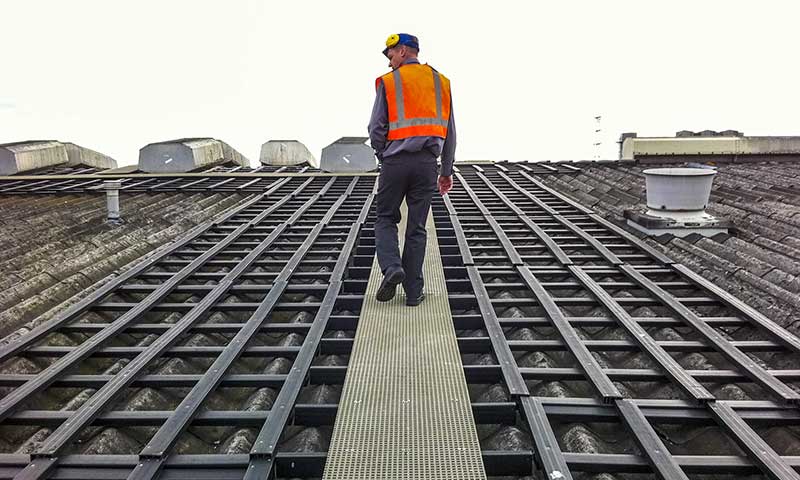In the scenic landscape of the Philippines, where beautiful rooftops often grace our properties, there’s an important aspect of building design that often goes unnoticed but plays a vital role in ensuring both safety and aesthetics: roof walkways. These unassuming additions to rooftops are not only functional but also have the potential to enhance the overall appeal of your property. In this blog post, we will explore the significance of roof walkways, the materials available, and how to strike the perfect balance between aesthetics and safety.
The Significance of Roof Walkways
A: Safety First
One of the primary reasons for installing roof walkways is safety. Whether you’re a property owner or a builder, ensuring safe access to rooftops is paramount. Roof walkways create designated paths for maintenance personnel, reducing the risk of accidents and injuries. By preventing unintended slips and falls, these walkways provide peace of mind to everyone working on or traversing the roof.
B: Protection for Your Roof
Roof walkways also play a crucial role in preserving the integrity of your roof. Without designated paths, constant foot traffic can lead to unnecessary damage to the roof surface. Over time, this damage can result in costly repairs or replacements. Installing walkways ensures that foot traffic is concentrated on specific areas, reducing wear and tear.
Types of Roof Walkway Systems
Now that we understand their significance let’s delve into the different types of roof walkway systems available.
A: Anti-Slip Walkways
Anti-slip walkway systems are designed to create safe, stable, slip-resistant, and level walking surfaces on rooftops. These walkways offer improved traction, especially in wet and icy conditions, making them essential for safety in a tropical climate like the Philippines.
B: Designated Paths
Designated paths are not just about safety; they also restrict access to off-limits areas. This is crucial for ensuring that only authorized personnel have access to certain parts of the rooftop, enhancing security and safety further.
Materials for Roof Walkways
When it comes to materials for roof walkways, two options are commonly used:
A: Aluminum
Aluminum walkways are known for their durability and non-corrosive properties. They are lightweight and can be installed without welding, making them a practical choice. The aluminum 6063 mill finish ensures an outstanding aesthetic, and they can even be equipped with guardrails for added safety.
B: Fiberglass
Fiberglass walkways are ideal for corrosive environments and offer the advantage of being lighter than aluminum while still incredibly strong. Like aluminum, they can be installed without welding and come in high-visibility colors like yellow or grey. Handrails can also be easily added for enhanced safety.
Balancing Aesthetics and Safety
A: Aesthetics Matter
Aesthetics are an important consideration when installing roof walkways. While safety is paramount, it doesn’t mean sacrificing the overall look of your property. Roof walkway systems can be integrated seamlessly into your rooftop design, enhancing both safety and visual appeal.
B: Aesthetic Examples
Consider rooftop gardens with aesthetically pleasing walkways, blending nature and safety seamlessly. Rooftop bars with stylish walkway designs offer patrons stunning views without compromising safety. The possibilities are endless.
Installation and Maintenance
A: Installation
Professional installation is key to ensuring the effectiveness of your roof walkway system. Depending on your choice of material and design, the installation process can vary, but it’s always best left to experts.
B: Maintenance
Regular maintenance is essential to ensure your walkways continue to perform their function. Professional services are available for routine check-ups, repairs, and replacements if necessary.
Case Studies
Explore some real-world examples of successful roof walkway installations in the Philippines:
- Green Oasis: A lush rooftop garden with fiberglass walkways seamlessly integrated into the landscape.
- Sky Lounge: A stylish rooftop bar with aluminum walkways providing safety without compromising the view.
Safety Regulations and Compliance
Before installing roof walkways, it’s important to familiarize yourself with relevant safety regulations in the Philippines. Compliance with these standards ensures the safety of your property and its occupants.
Conclusion
In the Philippines, where aesthetics and safety are both cherished, roof walkways offer the perfect solution to balance these two aspects. By choosing the right materials, designs, and installation experts, you can enhance the appeal of your property while ensuring the safety of everyone who sets foot on your rooftop.

